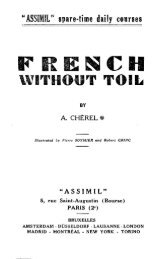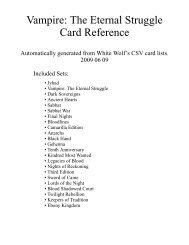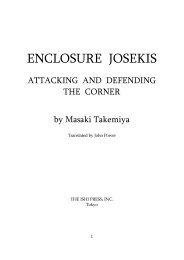Gentle Joseki.pdf - Computer Science Club
Gentle Joseki.pdf - Computer Science Club
Gentle Joseki.pdf - Computer Science Club
You also want an ePaper? Increase the reach of your titles
YUMPU automatically turns print PDFs into web optimized ePapers that Google loves.
Game example 1: Takemiya Masaki<br />
I don't think it actually was Takemiya "Cosmic Style" Masaki, 9 dan who started playing the<br />
ikken-tobi but he certainly seems to be fond of it.<br />
42nd Honinbo title match, game 1<br />
White: Yamashiro Hiroshi, 9 dan<br />
Black: Takemiya Masaki, 9 dan<br />
Moves: 1-14 (Black wins by 5.5 point).<br />
Here black 7 is played in, what I<br />
think, a very positive way of using<br />
hoshi stones, in this case the san-rensei<br />
formation of black 1-5-3. As I<br />
discussed in the first edition of<br />
<strong>Gentle</strong> <strong>Joseki</strong>, a stone on the 4-4<br />
point is not ideal if you are thinking<br />
about securing territory fast, white<br />
can play at the 3-3 point and there is<br />
not much black can do about it.<br />
Therefor, to give up on the idea of<br />
making territory in the corner for the<br />
time being only seems to be natural.<br />
Former Honinbo Takemiya was a<br />
master at this. He knew precisely<br />
when to let go of the corner and when<br />
it was important to solidify. In his top<br />
days his skill at using stones at 4-4 to<br />
create large frame works is perhaps<br />
unequaled. The play at 7 is<br />
undoubtedly proper if you are<br />
thinking about making a moyo. If black 7 were at the third line (keima) than it already feels if the<br />
moyo is falling short. To repeat the key point here: the black ikken-tobi response is ideal for<br />
moyo making and fighting, exactly what the hoshi move stands for in the first place! Playing at<br />
13 black is saying "well, the moyo is going as far as it goes, now I want to see what white is<br />
going to do about it". The answer is the cautious reducing move at 14.<br />
In the post game analyses of this game both players agreed that before playing at 9 black actually<br />
first should have played at A or at 10, in both cases white will probably answer and black will<br />
still be first to play at the bottom.<br />
The second reason I mentioned (attacking) for playing the ikken-tobi<br />
response is shown in dia 9. When white feels like playing elsewhere<br />
after black's response black will attack at the earliest convenient time<br />
with the kosumi-tsuke (diagonal clamp) at 1. Usually white will<br />
stretch at 2 after which black plays the severe looking pincer at 3. If<br />
the game were to continue like this the black ikken-tobi response is in<br />
a much better position to put pressure on white compared to the keima









